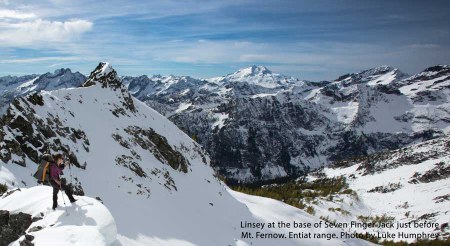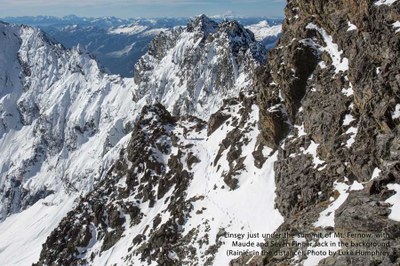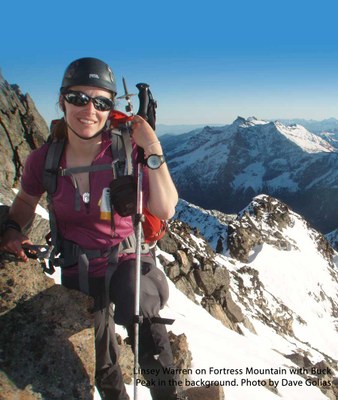
Sometimes our passions find us young. Sometimes they don’t find us at all – and sometimes, we’re born for a specific purpose. For me, that purpose was adventure. Specifically, the kind that can be found trekking, kick-stepping and climbing up a mountain. And especially, the kind that is done with friends.
Mountains captured my heart at a young age. I was born in Washington and grew up the youngest of three. My older brother and father were active in the Boy Scouts and it wasn’t long until I wanted to be as well – at least, I wanted to learn survival skills and go camping in the woods. My family always encouraged me to get outside, so when I was seven years old, my father took me on my first overnight igloo trip in Mount Rainier National Park. It set the tone for the rest of my life.
Not long after that, I was on a fifty-mile backpack trip where my dad imparted words of wisdom like “If you can’t carry it, you can’t have it.” This sense of independence and adventure continued with me when my family relocated to Europe. This provided me the opportunity to get involved with some incredible outdoor youth programs. But when I was fifteen, my family relocated back to Washington, where I found there weren’t any rigorous outdoor programs tailored to youth.
That was when a family friend suggested I look into The Mountaineers. At the time, The Mountaineers did not offer many youth activities, so I set my sights on the Basic Alpine Climbing course. In order to take the course as a youth, you had to have an adult chaperone - unless, you were sixteen with parental consent. I got the feeling the ‘unless’ wasn’t used very frequently. When I applied, I had to submit a resume of outdoor activities and interview with someone from the club before being admitted.
Looking back, it took a lot of trust and faith for me to join the adult class. Firstly, my parents let me go through the program by myself, surrounded by different adults — primarily men, every weekend. It was inspiring and transforming for me. The Mountaineers gave me the chance to experience the mountains with a sense of independence I never otherwise would have. And I’m forever grateful to my mentors, who took a chance and let a sixteen-year-old girl join their high-intensity mentor group.
During my senior year of high school, I started the Intermediate climbing program. I finished it as a college student at the University of Puget Sound. While there, I joined the Tacoma Mountain Rescue Unit. What an eye-opening experience! I learned about the tragedies and rescues going on in my mountain-climbing neighborhood, first-hand. The rescue-techniques, people, and stories stay with me on climbs today.

It wasn’t until the summer after graduating that I found the ‘Bulger List’. I was on a Mountaineers climb of Argonaut Peak when someone casually mentioned it.
When I first heard of the list, I thought I had done seven peaks. And in my head, seven was close to ten — which is one-tenth of the way done. And if that one tenth wasn’t too hard, how hard could the other nine-tenths be? As it turned out, I had actually only done three, and it was going to be a lot harder than I expected. But I never doubted myself.
It just never occurred to me that I couldn’t do it. It occurred to me that I might be injured or killed. But never that I couldn’t do it. And even on days when I was tired, and cold, and wanted to give up, the part of me that knew I could do it persevered.
And I did persevere. But success wasn’t found alone. Wonderful friends and partners made the journey with me. And made the journey memorable.
My friend and long-time climbing partner, Dave Golias recollects some of our shared adventures:
We went up there in June as soon as the road opened. It was one of those trips where everything seemed to go right. The weather was beautiful. There was still a fair amount of snow, so the bushwhacking wasn’t too bad. The mountains were stunning. Before the trip, Linsey had been listening to the soundtrack of Les Miserables. Then, as we went up the mountain, she would spontaneously start singing one of the songs. The songs gave the trip a surreal feeling. We set up camp in a lovely basin and got to the summit with time to relax and enjoy the sights. Then, we headed down to camp while the sunset over Glacier Peak.
One funny incident happened on our Kimtah and Cosho trip. After climbing Kimtah, we spent the night on this little ledge on the side of the mountain. In the middle of the night, I hear “Dave, wake up. I think there might be bugs all over my bivvy. It might have been a dream. Get your light and check.” I was still half asleep. It took me a little while to remember where I was, and a some of fumbling around in the dark to find my light. A quick inspection revealed no bugs on Linsey’s bivvy. When I informed her of the lack of bugs, I heard a very relieved sounding “oh good,” and Linsey instantly fell back asleep.
Most of my climbing partners happen to be men, and I said jokingly one summer that I was “working my way through the guys.” Climbing with one partner one weekend, then giving them a weekend off and heading out with the next friend on the list. It’s grueling work, and when I invited someone on a trip, I tried not to sugarcoat it — and almost tried to make it sound worse than it might be, just so my partner was prepared. I threw around words like, ‘no sleep’, ‘loose rock’, ‘hellacious bushwhack’, ‘minimal water’, ‘heavy packs’ etc. And if anyone agrees to venture out, after hearing those terms, I figure they’re ready for whatever the mountains may bring us that day.
There’s something compelling about climbing. It’s exciting and challenging. A chance to push myself to levels I’ve never been before. It’s that challenge that makes it addicting — to see how far I can make it in a day. To see how many peaks I can squeeze into a weekend, or to try a new variation on a route. It’s about seeing how much I can do, and then trying to do better. It helps me grow physically and mentally as I learn to handle new obstacles that cross my path. The mountains are my teachers. And in a way, they are the best teachers, because there is no such thing as fair or unfair. No breaks or timeouts. You’re wholly responsible for your own actions, and your own self.
It took me five years to climb the remaining 97 peaks. Overall, the 100 peaks took 62 trips, totaling 142 days backcountry, not including unsuccessful attempts. Climbing the Bulger peaks comes out to approximately 500,000 vertical feet of elevation gain, which is about equivalent to climbing Everest eleven times from sea to summit. The culmination of this journey was on Windy Peak, September 27th 2014, when, accompanied by my friends, husband and parents, I ascended to the top of my final summit.
It was hard to see it as an end. We popped a bottle of bubbly, signed the register and celebrated. And it felt wonderful. I felt all of the energy that had been driving me for years recognize the moment. But at the same time, since I have no intention of stopping climbing, it also didn’t feel like an end.
Proportionally, little time from a trip is spent on a summit. The majority of the memories and experiences are had anywhere but the summit. So although the summit is a milestone and achievement, it is all the little everyday moments that define a trip and make it memorable.
It’s walking until you fall asleep while eating salami and crackers. Or losing your sunglasses the first day of a six-day trip and wearing duct tape sunglasses. It’s having people sing happy birthday on a mountain while giving you a piece of a Payday with a tea light candle on it. It’s these special moments with friends that turn an exhausting day into an unforgettable adventure.

 Linsey Warren
Linsey Warren